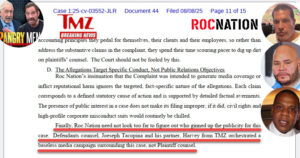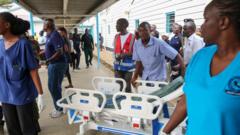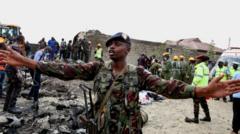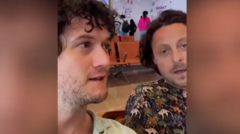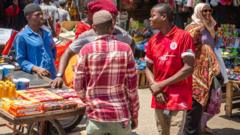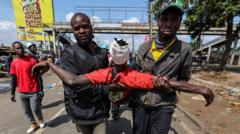A shocking undercover investigation by BBC Africa Eye has uncovered the grim reality of child prostitution in Maai Mahiu, Kenya. Through secret filming, the report reveals how women, referred to as 'madams,' exploit vulnerable minors as young as 13 in the thriving sex trade of this key transport hub. With little law enforcement action, many of these children remain trapped in a cycle of abuse.
Exposé Reveals Underage Prostitution in Kenya's Maai Mahiu

Exposé Reveals Underage Prostitution in Kenya's Maai Mahiu
An undercover investigation by BBC Africa Eye exposes the involvement of women 'madams' in child prostitution in the Kenyan town of Maai Mahiu, where underage girls are being manipulated into sex work.
In the transit town of Maai Mahiu, located in Kenya's Rift Valley, an alarming underground network has emerged, centered around child prostitution. A recent investigation by BBC Africa Eye has cast a spotlight on this troubling issue, revealing how women referred to as "madams" exploit vulnerable minors, some as young as 13, within a notoriously active sex trade.
Located just 50 kilometers east of Nairobi, Maai Mahiu is a crucial trucking hub connecting Kenya with its East African neighbors. Undercover investigators pretended to be new sex workers looking to become madams themselves, spending months gathering evidence on the dark underbelly of the local prostitution market.
During their inquiry, the investigators met two women who openly admitted to introducing minors into the sex industry. In a chilling revelation, one woman named Nyambura confessed that manipulation was easy, stating, "They're still children, so it's easy to manipulate them by just handing them sweets." Despite knowing the legality issues, these madams feel they operate in a system normalized by the ubiquitous presence of truck drivers.
Though the act of adult prostitution is largely tolerated in Maai Mahiu, living off the earnings from it remains illegal. The issue of underage prostitution raises even more serious legal questions, as the trafficking of minors attracts severe penalties. However, those responsible for these practices often evade justice, partly due to minors' reluctance to testify against them.
The investigation’s footage highlights the grim realities faced by young girls in the industry, with one victim revealing she has to comply with clients' demands without protection, demonstrating how their exploitation is perpetuated and exacerbated by fear and societal stigma.
The scope of child prostitution in Kenya remains difficult to gauge; estimates suggest that thousands of minors are susceptible to this crime. In the absence of concrete data and rigorous law enforcement, many young girls continue to be ensnared in this vicious cycle.
Though some former sex workers like "Baby Girl" now provide refuge for abused children in Maai Mahiu, the plight of these girls remains harrowing. Many arrive seeking a better life, only to fall victim to exploitation and violence.
Former survivors like Michelle and Lilian bravely recount their stories of abuse and exploitation; with support from outreach workers like Baby Girl, they are now re-integrating into society and learning new skills. However, ongoing funding cuts to vital support programs threaten the few resources available to these vulnerable individuals.
As Baby Girl prepares for the impact of reduced aid, she expressed concern for the future of the young girls dependent on her assistance. With their safety hanging in the balance, it raises pressing questions about the societal mechanisms needed to protect these children in the face of relentless exploitation.
Located just 50 kilometers east of Nairobi, Maai Mahiu is a crucial trucking hub connecting Kenya with its East African neighbors. Undercover investigators pretended to be new sex workers looking to become madams themselves, spending months gathering evidence on the dark underbelly of the local prostitution market.
During their inquiry, the investigators met two women who openly admitted to introducing minors into the sex industry. In a chilling revelation, one woman named Nyambura confessed that manipulation was easy, stating, "They're still children, so it's easy to manipulate them by just handing them sweets." Despite knowing the legality issues, these madams feel they operate in a system normalized by the ubiquitous presence of truck drivers.
Though the act of adult prostitution is largely tolerated in Maai Mahiu, living off the earnings from it remains illegal. The issue of underage prostitution raises even more serious legal questions, as the trafficking of minors attracts severe penalties. However, those responsible for these practices often evade justice, partly due to minors' reluctance to testify against them.
The investigation’s footage highlights the grim realities faced by young girls in the industry, with one victim revealing she has to comply with clients' demands without protection, demonstrating how their exploitation is perpetuated and exacerbated by fear and societal stigma.
The scope of child prostitution in Kenya remains difficult to gauge; estimates suggest that thousands of minors are susceptible to this crime. In the absence of concrete data and rigorous law enforcement, many young girls continue to be ensnared in this vicious cycle.
Though some former sex workers like "Baby Girl" now provide refuge for abused children in Maai Mahiu, the plight of these girls remains harrowing. Many arrive seeking a better life, only to fall victim to exploitation and violence.
Former survivors like Michelle and Lilian bravely recount their stories of abuse and exploitation; with support from outreach workers like Baby Girl, they are now re-integrating into society and learning new skills. However, ongoing funding cuts to vital support programs threaten the few resources available to these vulnerable individuals.
As Baby Girl prepares for the impact of reduced aid, she expressed concern for the future of the young girls dependent on her assistance. With their safety hanging in the balance, it raises pressing questions about the societal mechanisms needed to protect these children in the face of relentless exploitation.


